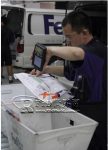
Boosting Postal Delivery Speed with RFID
[ad_1]
On April 4, 2007, the Spanish postal service Correos is using an RFID system to detect every point of inefficiency in the delivery process. The system shares 340 readers and more than 2,000 antennas, and is installed in 16 automatic processing centers (APCs) and 4 large mail processing centers across the country. This system is currently the largest application example of the second-generation EPC technology in the global UHF band.
Correos’ RFID system was put into use in November 2006, and Spain’s Postal Service partnered with a third-party company to use 5,000 second-generation passive tags to monitor the delivery of letters throughout the postal system. By tracking letters, Correos has identified many areas for improvement in the delivery process.
The hardware for the system is provided by Motorola’s Mobile Business Division (formerly Symbol Technologies), the software is provided by Sybase iAnywhere, and the system integration is implemented by the Aida Center in Barceló.

The second-generation RFID tags are posted next to letter addresses and are initially read by fixed antennas at four mail processing centers. When the mail leaves the mail processing center, the label is read again. During the mailing of letters, the mail is read every time it passes through the APC or other small post office. In addition to these fixed RFID readers, some are installed on transport systems and parcel sorters. At each read point, the unique number and time stamp of the letter’s label is sent over the network to the Sybase iAnywhere Software Center. After the letter reaches its destination, the tags are collected and reused.
Correos employs 65,000 people and delivers 5 billion pieces of mail each year. 5,000 RFID-tagged envelopes are used repeatedly in the company’s entire postal system. Statistical analysis of the postal system allows company managers to clearly understand the current address of the letter and where it is delayed.
During the investigation, Martyn Mallick, director of iAnywhere’s RFID business, found that: Sometimes, a letter takes five days or more to reach its destination, but some letters only take one day. With this RFID system, Correos can know what is causing the slow delivery, and then make adjustments to the delivery system to prevent similar incidents from happening. The company believes that this will improve the quality of their service and increase their competitiveness with private mail companies.
During the implementation of the project, in order to ensure that emails are not missed, a center needs to install 36 readers. During the test, the Correos postal department found that even if these readers were adjusted to the “second-generation multi-reader mode”, there was still mutual interference when the readers worked in coordination. To remedy this problem, iAnywhere and Symbol have installed motion sensors in the Aida Center, so that the reader will only be triggered to work when the mail passes through the antenna of the reader, which greatly reduces the number of readers working at the same time.
According to Mallick, Correos plans to add an RFID-based asset tracking program that will use 12,000 second-generation tags to track the postal system’s reusable mailboxes. Eventually, Correos’ courier business may replace its current bar code system with an RFID system to provide customers with tracking information.
[ad_2]



